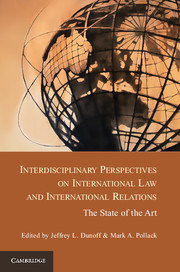 Interdisciplinary Perspectives on International Law and International Relations
Interdisciplinary Perspectives on International Law and International Relations Book contents
- Frontmatter
- Contents
- Contributors
- Acknowledgments
- Part I Introduction: Setting the Stage
- Part II Theorizing International Law
- Part III Making International Law
- Part IV The Interpretation and Application of International Law
- Part V Enforcement, Compliance, and Effectiveness
- 19 The Engines of Compliance
- 20 Coercive Enforcement of International Law
- 21 Reputation in International Relations and International Law Theory
- 22 Open Economy Law
- 23 Persuading to Comply
- 24 Against Compliance
- Conclusions
- Index
- References
23 - Persuading to Comply
On the Deployment and Avoidance of Legal Argumentation
Published online by Cambridge University Press: 05 January 2013
- Frontmatter
- Contents
- Contributors
- Acknowledgments
- Part I Introduction: Setting the Stage
- Part II Theorizing International Law
- Part III Making International Law
- Part IV The Interpretation and Application of International Law
- Part V Enforcement, Compliance, and Effectiveness
- 19 The Engines of Compliance
- 20 Coercive Enforcement of International Law
- 21 Reputation in International Relations and International Law Theory
- 22 Open Economy Law
- 23 Persuading to Comply
- 24 Against Compliance
- Conclusions
- Index
- References
Summary
For those international actors seeking to promote respect for international law, persuasion is at the core of the enterprise. By persuasion, I mean a process of social interaction whereby one actor seeks to convince another to believe or do something through principled rational arguments and interactions, without any overt coercion (Checkel 2001: 562). Whether in arguments to the noncomplying entity itself, to an authority with the capacity to impose costs for noncompliance, or to an interpretive body charged with offering legal opinions regarding noncompliance, international law encompasses a constant process of communication over conduct and consequences. Yet, beyond this seemingly obvious starting point to the international lawyer – although not to all political scientists – the scholarship on compliance is woefully thin on the precise content of such a communication of persuasion, and, in particular, on the role of legal argumentation in that process. We can all agree generally on the contours of an argument to a court, but most persuasive strategies are not aimed at courts. In those situations, what determines an actor's persuasive strategy and the role for law in it?
This chapter constructs a theoretical model for answering these questions. My approach is fundamentally inductive, based on experience in two organizations whose central mission entails the deployment of persuasion to achieve compliance with international norms – the Organization for Security and Cooperation in Europe (OSCE) High Commissioner on National Minorities and the International Committee of the Red Cross (ICRC). It is also, however, informed by debates within political science and law on modes of compliance and is intended to be generalizable. These institutions’ methods show that a compliance strategy can invoke a range of law, along several dimensions, and that the choices regarding the argumentation to use are highly contextual. This practice contrasts with static or unidimensional approaches to the modalities of persuasion and the role of law assumed by most scholarship on compliance.
- Type
- Chapter
- Information
- Interdisciplinary Perspectives on International Law and International RelationsThe State of the Art, pp. 568 - 590Publisher: Cambridge University PressPrint publication year: 2012
References
- 4
- Cited by


